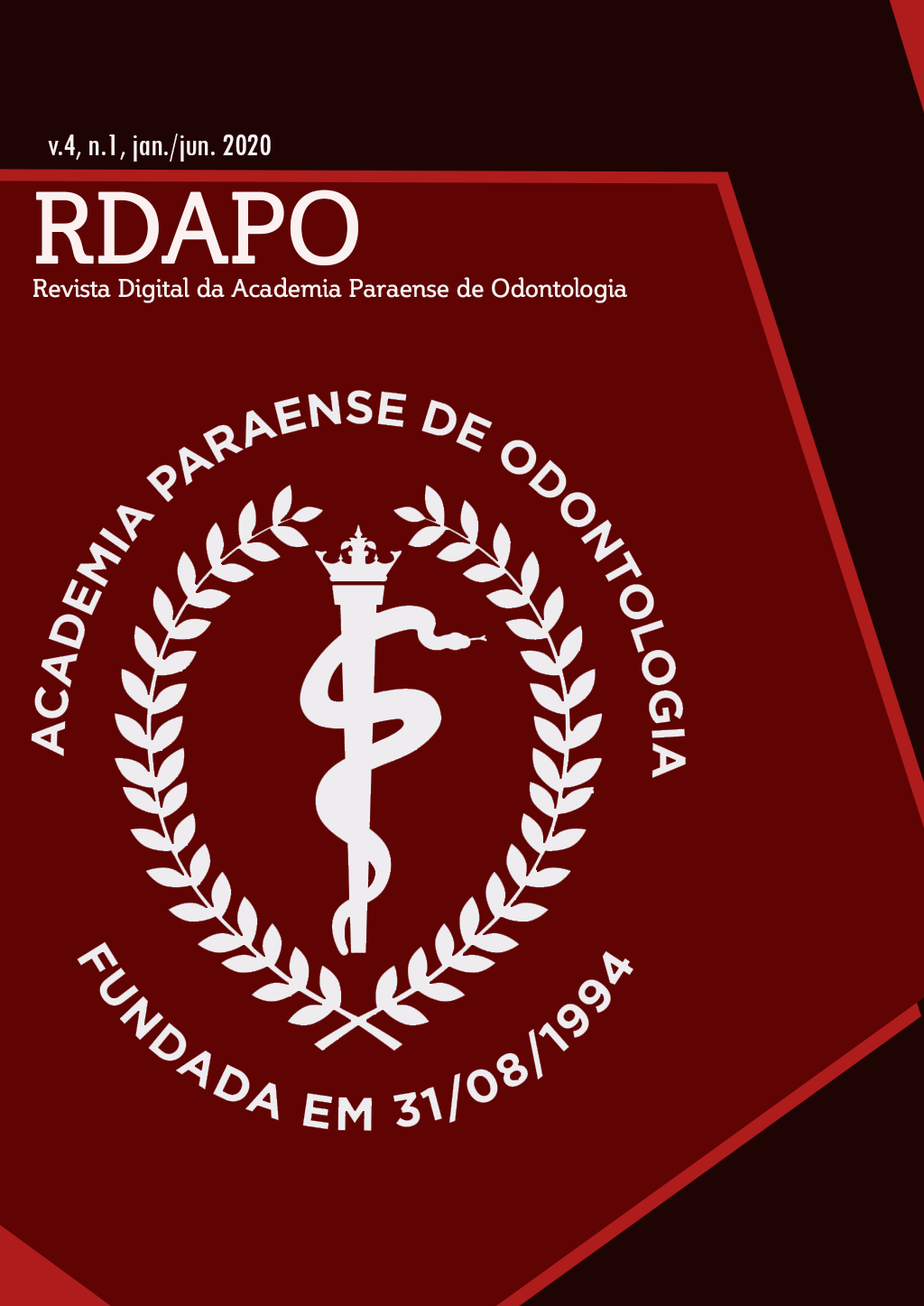Abstract
The aesthetic changes caused by the color change of the dental elements present as the main complaints in the dental offices and represent a challenge for dentists. Enamel microabrasion is a safe, easy-to-use, conservative technique that, when properly applied, is a good alternative for the treatment of superficial enamel stains. The technique is based on the concomitant use of an acid with abrasive agent applied on the affected dental surface. The objective of this study is perform a literature review, to discuss the state of the art and the different techniques employed. The databases Pubmed, Scielo, Bireme, Lilacs, Google Scholar and Periódicos Capes were used to search for articles on the subject, published in the last twenty five years. Over the years different abrasive substances, types and concentrations of acids were used. Currently, 6% hydrochloric acid combined with silicon carbide or 37% phosphoric acid associated with pumice stone are the most commonly used products for performing the technique. In both, the aesthetic results are satisfactory, with little dental wear, safety of application, regularization of the enamel structure and recovery of the color pattern, meeting the expectations of the patient. Thus, it can be said that the use of enamel microabrasion should be the technique of first choice when a minimally invasive approach is desired.
References
Hermes, SR. Microabrasão do esmalte dental para tratamento de fluorose. RGO - Rev Gaúcha Odontol. 2013; 61(2): 427-433.
Mondelli J, Mondelli RFL, Bastos MTAA, Franco EB. Microabrasão com ácido fosfórico. Rev Bras Odontol. 1995; 52(3): 20-22.
Santos AA, Machado NMF, Nascimento F, Dietrich L, Andrade CMO. Remoção de manchas no esmalte dental pela técnica de microabrasão: revisão de literatura. Rev Odontol Contemporânea. 2018; 2(1):51-59.
Croll TP, Cavanaugh RR. Enamel color modification by controlled hydrochloric acid-pumice abrasion: technique and examples. Quintessence Int. 1986; 17(2): 81-87.
Oliveira LKM, Carvalho LAO, Borges BCD, Santos AJS, Carvalho WL, Dantas EDV. Microabrasão na estética dentária: sucesso com procedimento minimamente invasivo. Ciência Plural 2015; 1(3): 76-84
Catelan A, Pini NIP, Hernandes MNP, Lima DANL, Aguiar FHB. Técnicas minimamente invasivas para resolução estética de manchamentos dentais. Arch Health Invest. 2014; 3(4):1-8.
Kabaach W. Abordagem conservadora para o tratamento da hipoplasia do esmalte. Int J Braz Dent. 2010; 6(2):130-141.
Sundfeld RH, Sundfeld-Neto D, Machado LS, Franco LM, Fagundes TC, Briso AL. Microabrasion in tooth enamel discoloration defects: three cases with long-term follow-ups. J Appl Oral Sci. 2014; 22: 347-354.
Silva LX, Sampaio PPC, Luna TL, Santos AFL. Associação de clareamento e microabrasão de esmalte em um caso de Fluorose dental, uma alternativa estética e conservadora: relato de caso. RCO. 2020; 4(2): 17-25.
Neville BW et al. Patologia Oral &Maxilofacial. 3ed. Rio de Janeiro: Elsevier; 2009.
Coelho ASEC, Mata PCM, Lino CA, Macho VMP, Areias CMFGP, Norton APMAP, Augusto APCM. Dental hypomineralization treatment: A systematic review. J Esthet Restor Dent. 2018; 1–14.
Costa ACS, Moura MDS, Emmi DT. Técnica de microabrasão empregada para estética do sorriso com hipoplasia do esmalte: Relato de caso. Rev Paraense Odontol. 2016; 1:5-11.
Segura A, Donly KJ, Wefel JS. The effects of Microabrasion on demineralization inhibition of enamel surfaces. Quintessence Int. 1997; 28: 463-466.
Pini NIP, SundfeldNeto D, Aguiar FHB, Sundfeld RH, Martins LRM, Lovadino JR, Lima DANL. Enamel microabrasion: An overview of clinical and scientific considerations. World Journal of Clinical Cases: WJCC. 2015; 3(1): 34-41.
Zenkner JEA, Gallarreta FWM, Santos MM, Zenkner CL. Fluorose dental: aspectos históricos, etiopatogênicos e clínicos. Saúde. 2005;31(1-2):34-41.
Bosquiroli V, Ueda JK, Baseggio W. Fluorose dentária: tratamento pela técnica da microabrasão associada ao clareamento dental. Rev Odontol UFES. 2006; 8(1):60-65.
Meireles SS, André DA, Leida FL, Bocangel JF, Demarco FF. Surface roughness and enamel loss with two microabrasion techniques. J Contemp Dent Pract. 2009; 10(1): 58-65.
Paic M, Sener B, Schug J, Schmidlin PR. Effects of microabrasion on substance loss, surface roughness, and colorimetric changes on enamel in vitro. Quintessence Int. 2008; 39(6): 517-522.
Hoeppner MG, Alferes Araújo CS, Carvalho MS. Microabrasão do esmalte dental: relato de um caso clínico. Rev Odontol UFES. 2007; 9(2):51-56.
Sheoran N, Garg S, Damle SG, Dhindsa A, Opal S, Gupta S. Esthetic management of developmental enamel opacities in young permanent maxillary incisors with two microabrasion techniques - a split mouth study. J Esthet Restor Dent. 2014; 26(5): 345-352.
Fontes NM, Pessoa T, Martins ME. Conservative techniques for treatment of dental fluorosis: clinical case report. J Clin Dent Res. 2017;14(4):48-57.
Zuanon ACC, Azevedo ER, Lima LM, Santos-Pinto LAM. Desgaste superficial do esmalte dental após microabrasão in vitro. Rev Odontol UNESP. 2010; 39(4): 207-211.
Croll TP; Helpin ML. Enamel microabrasion: a new approach. J Esthet Dent, 2000;12(2):64-71.
Cunha LF, Souza JF, Baechtold MS, Correr GM, Nescimento BL, Gonzaga CC. Microabrasion. Rev Odontol Cienc. 2016;31(1):36-40.
Oliveira LMX; Novaes Júnior JB; Barreiros ID; Paiva SM; Martins CC. Tratamento de fluorose dentária moderada com a técnica de microabrasão de esmalte com ácido clorídrico 6% e carbeto de silício: relato de caso clínico. Arq Odontol. 2014;50(3):142-148.
Queiroz VAO, Martins GC, Zander-Grande C, Gomes JC, Campanha NH, Jorge JH. Report of two microabrasion techniques of enamel to remove stains and discussion. Rev Odontol UNESP. 2010; 39(6):369-372
Prado-Júnior RR; Ribeiro RC; Brito AC; Lopes TSP. Microabrasão como tratamento do esmalte fluorótico. Rev Gaúcha Odontol. 2008;56(2):21-26.
Gomes RP, Montenegro G. Microabrasão do esmalte associada ao clareamento dental. ROBRAC. 2011; 2(1):16-21.
Castro ALS, Mendes CMC. Microabrasão e clareamento em dentes com fluorose: relato de um caso clínico. Rev Ciênc Med Biol. 2014; 13(3): 403-408.
Vieira-Dantas ED, Cavalcanti YW, Carvalho WL, Pinheiro IVA, Santos AJS. Clareamento dentário como etapa prévia à restauração de dentes com alteração severa de cor. Rev Bras Ciênc Saúde. 2014; 18(1): 41-48.

This work is licensed under a Creative Commons Attribution 4.0 International License.
Copyright (c) 2020 Revista Digital APO

